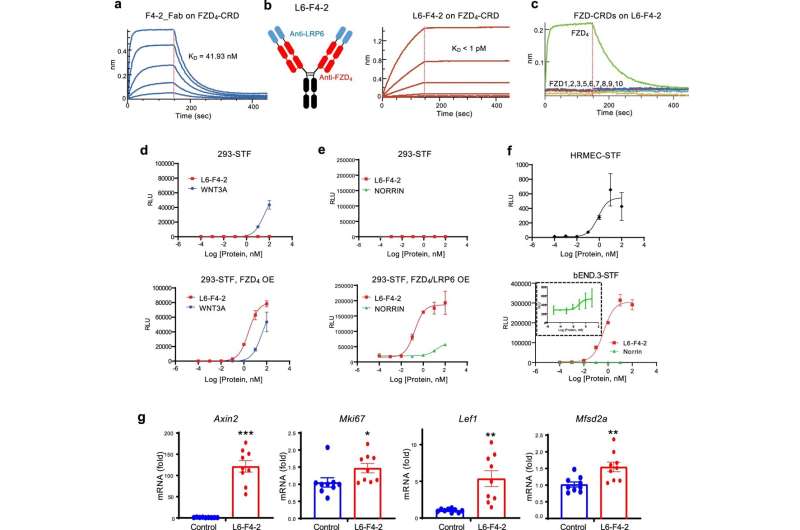This article has been reviewed according to Science X's editorial process and policies. Editors have highlighted the following attributes while ensuring the content's credibility:
fact-checked
peer-reviewed publication
trusted source
proofread
Restoring the blood-brain barrier using a novel WNT signaling pathway

There's a bouncer in everyone: The blood-brain barrier, a layer of cells between blood vessels and the rest of the brain, kicks out toxins, pathogens and other undesirables that can sabotage the brain's precious gray matter.
When the bouncer is off its guard and a rowdy element gains entry, a variety of conditions can crop up. Barrier-invading cancer cells can develop into tumors, and multiple sclerosis can occur when too many white blood cells slip pass the barrier, leading to an autoimmune attack on the protective layer of brain nerves, hindering their communication with the rest of the body.
"A leaky blood-brain barrier is a common pathway for a lot of brain diseases, so to be able to seal off the barrier has been a long sought-after goal in medicine," said Calvin Kuo, MD, Ph.D., the Maureen Lyles D'Ambrogio Professor and a professor of hematology.
Methods of repairing the blood-brain barrier remain understudied, according to Kuo. But a recent paper he and colleagues led describes a treatment that could be instrumental in restoring the barrier's normal function. Kuo is the senior author of the paper, published in Nature Communications.
"We have evaluated a new therapeutic class of molecules that can be used to treat a leaky blood-brain barrier; previously, there were no treatments directed at the blood-brain barrier specifically," Kuo said.
The researchers started their quest by looking at WNT signaling, a communication pathway used by cells to promote tissue regeneration and wound healing. WNT signaling helps maintain the blood-brain barrier by promoting cell-to-cell communication that lines brain blood vessels.
"There's a lot of historical data that indicated that the WNT signaling pathway would be important for maintaining the blood-brain barrier," Kuo said. "The opportunity arose to test a novel WNT signaling pathway that would turn on signaling in the blood-brain barrier by binding very selectively to a receptor called frizzled."
Scientists have been focusing on frizzled, a protein receptor that initiates the WNT pathway, for blood-brain barrier therapies since mouse mutations in the frizzled gene cause blood-brain barrier abnormalities.
How it's made
Many different molecules bind to frizzled protein receptors, so to narrow their search for a potential therapeutic molecule, the researchers selected only those that specifically target cells that line the brain's blood vessels.
Chris Garcia, Ph.D., a professor of molecular and cellular physiology as well as the Younger Family Professor, developed prototype therapeutic WNT pathway molecules in the lab, including a molecule that activates the frizzled receptor FZD4. Building off of the work of Garcia and Kuo, collaborators at a research company created L6-F4-2, a FZD4 binding molecule that activates WNT signaling 100 times more efficiently than other FZD4 binders.
When the team, including Jie Ding, a research scientist and the lead author of the paper, activated WNT signaling at a higher rate, they saw an increase in blood-brain barrier strength.
Keeping the bouncer on duty
The researchers wanted to study what happens when the natural molecular key for frizzled is missing, and whether it can be replaced successfully with L6-F4-2. So they turned to Norrie disease, a genetic abnormality that results in a leaky blood-retinal barrier.
The blood-retinal barrier performs the same function for the eye as the blood-brain barrier does for the brain. In Norrie disease, the development of blood vessels of the retina—the layer of light-sensitive cells in the back of the eye—is hindered, resulting in leaky blood vessel connections, improper development and blindness.
Norrie disease results from mutations in the NDP gene, which provides instructions for making a protein called Norrin, which is the key that fits the lock of the FZD4 receptor and turns it on. In the study's mice, the gene is inactivated, and the key is missing causing a leaky barrier and blindness. The scientists replaced the missing Norrin protein with L6-F4-2, which they call a surrogate.
When L6-F4-2 replaced the missing Norrin protein, the blood-retinal layer was restored in the mice. Researchers knew this because they imaged the blood vessels and found them to be denser, and less leaky, than before treatment. Scientists also showed that, for the blood-brain barrier surrounding the mice cerebellum—a region responsible for muscle coordination—L6-F4-2 replaced Norrin and activated WNT signaling.
Next, the researchers wanted to study a more common human condition—ischemic stroke (in which blood vessels and the blood-brain barrier are damaged, and fluid, blood and inflammatory proteins involved in cellular communication can leak into the brain. They found that L6-F4-2 reduced the severity of stroke and improved survival of mice compared with mice that had untreated strokes. Importantly, L6-F4-2 reversed the leakiness of brain blood vessels after stroke.
Mice treated with L6-F4-2 had increased stroke survival, compared to those that were not treated.
The finding shows that, in mice, the blood-brain barrier could be restored by drugs that activate FZD receptors and the WNT signaling pathway.
Because a variety of disorders have their origin in blood-brain barrier dysfunction, Kuo is excited about the treatment potential for a variety of other neurological diseases, such as Alzheimer's, multiple sclerosis and brain tumors.
"We hope this will be a first step toward developing a new generation of drugs that can repair the blood-brain barrier, using a very different strategy and molecular target than current medications," Kuo said.
More information: Jie Ding et al, Therapeutic blood-brain barrier modulation and stroke treatment by a bioengineered FZD4-selective WNT surrogate in mice, Nature Communications (2023). DOI: 10.1038/s41467-023-37689-1



















